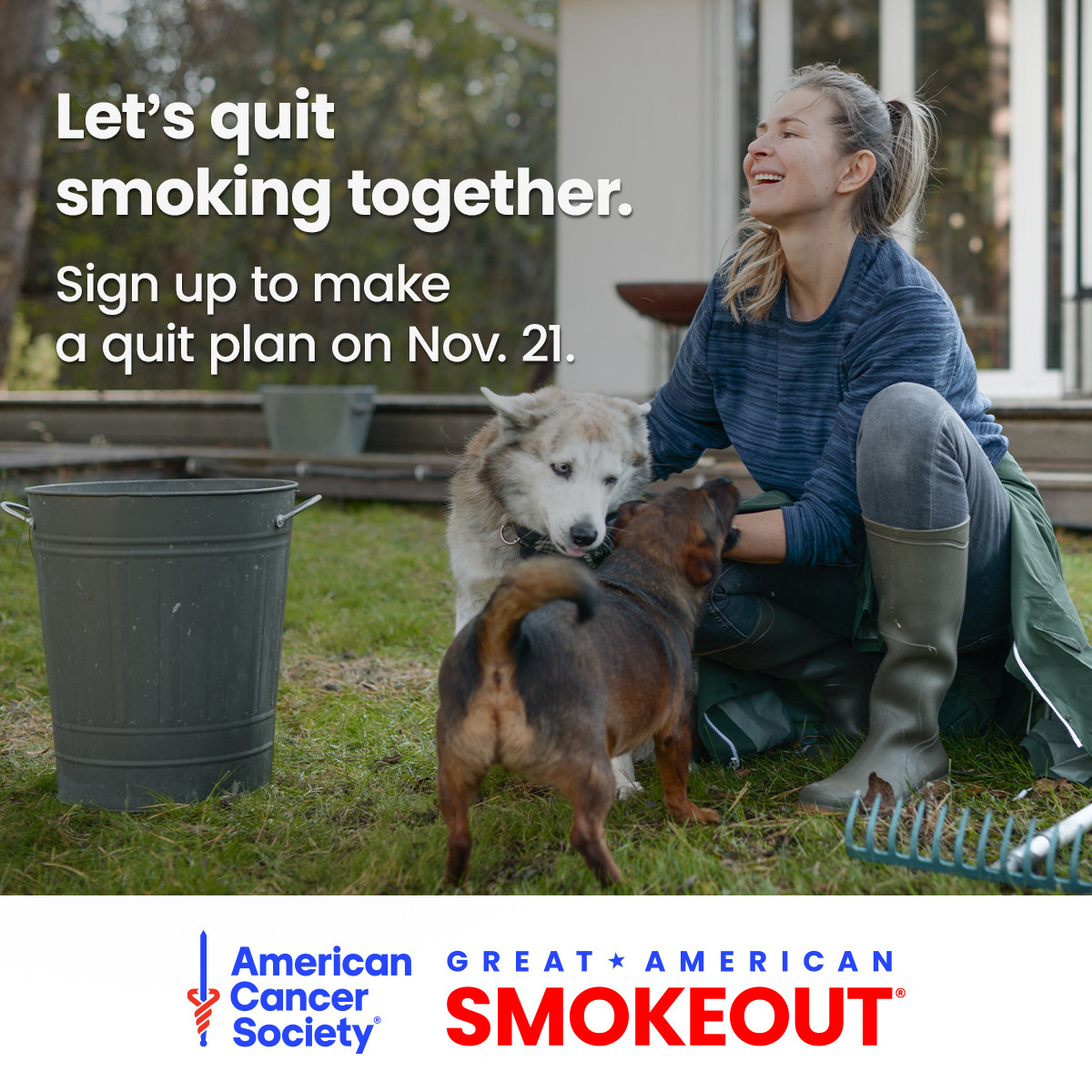 By Nicole Zenk, CNP, TTS, Family Medicine, Trained Tobacco Specialist
By Nicole Zenk, CNP, TTS, Family Medicine, Trained Tobacco Specialist
Great American Smokeout – Thursday, November 21
You don’t have to stop smoking in one day. Start with day one.
The thought of quitting can be overwhelming. Nicotine addiction and the behaviors of smoking are deeply rooted in a smoker’s life, no matter your age or how long you’ve been smoking. However, quitting improves health both immediately and over the long term. If you want to make a change, there is one consistent theme to success. HAVE A PLAN.
Giving up smoking or any nicotine use is a journey, and it can be hard, but you increase your chances of success with a good plan and support. Getting help through counseling and medications doubles or even triples your chances of quitting successfully! This plan needs to cover the four areas that are affected by smoking: addiction, the social component, the emotional component, and the behavioral component. Developing a plan gives you a framework to fall back on when you hit roadblocks in your quitting journey.
10 Quit Tips:
- Pick a Quit Date. Research shows that having a quit date picked out does help people quit because it gives you a tangible day. Having an idea to quit “next week” or “soon” can derail your quit before it even begins since next week or soon never really arrives.
- Let your support network know you are planning to quit. It can be scary to let people know about a quit attempt because of fear of failure. However, this allows people to help support you as you fight a tough battle or maybe quit with you. Your friends, family, and coworkers can encourage you as you work on becoming tobacco-free. If you are supporting a smoker to quit, don’t nag them. Be kind and listen. They don’t need you to tell them that smoking is bad for them. They know that.
- Gather a Quit Kit. (water bottle, stress ball, gum, toothpicks, fidgets, candy) Smokers who are quitting often find that they need something to hold in their hand or mouth to help replace the cigarette they were used to holding throughout the day. Drinking a lot of water helps to reduce nicotine cravings, as does peppermint.
- Are you going Cold Turkey or using Nicotine Replacement Therapy (NRT) or medication? Contact a Tobacco Cessation Specialist or your provider to discuss options. There are several nicotine replacements and medications to help reduce nicotine cravings. You begin taking medications about a week before the quit date, so schedule an appointment early. It’s also okay to change your mind about using NRT or medication. Providers will support your quit in the best way for you.
- Identify your triggers. Knowing what things trigger your urge to smoke helps you plan how to overcome them. Common triggers include talking on the phone, driving in the car, eating, and drinking alcohol. We can’t give up these things, but we can plan what to do instead of smoking when the triggers occur.
- Make a plan to handle stress. It’s okay to step away from a stressful situation and not smoke. Maybe you will practice deep breathing, walk, or play a quick game on your phone. Try anything that helps you calm down besides smoking.
- On your Quit Date, get rid of your tobacco items. Non-smokers don’t need ashtrays or tobacco products. Give them away or throw them away. If you have a sentimental item, it’s okay to keep it but put it away so it’s not in a place to be used.
- Plan to Handle Cravings. Use distraction, gum, breathing, or talking to a support person. Be prepared to use these strategies when cravings hit.
- Plan for slips. We’re human. A slip is not a failure. Keep going! Practice makes perfect, and each quit attempt, even if you slip, is practice for the final, successful quit.
- Reward yourself for your successes. What would you like to do with the health, time, and money you gain by not using tobacco or nicotine products?
The journey to tobacco freedom begins with a single step.
The journey will be a little easier if you have a road map. Consider joining this year’s Great American Smoke Out on Thursday, November 21, 2024. This is the 48th year of the national event. On November 21, 1976, the California Division of the American Cancer Society successfully helped 1 million people quit smoking for the day, marking the first Great American Smokeout. It is now held on the third Thursday of every November because of the success of this challenge. Quit for the day. See how it feels. Maybe it’s not as bad as you expect and may help you take the next step in your quit journey.
If you want to learn more about quit medicines, need help planning your quit, or are looking for support in quitting, our Nurse Practitioner, Nicole Zenk, a Tobacco Cessation Specialist, can help you discuss your personalized quit journey. Call 320.346.2272 to schedule an appointment with Nicole at Brooten Medical Center.



